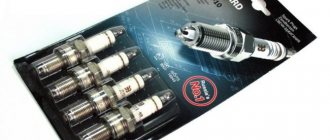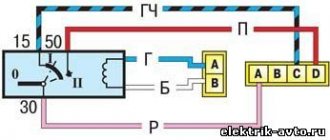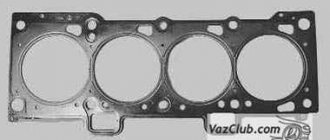Priora 21703, Bosch 7.9.7, firmware B174DR04. The problem started at the beginning of winter. When the engine started, it stalled or stalled heavily, but when it warmed up, everything worked perfectly. Yes, by the way, on gas it started normally and worked without problems.
I went to various diagnosticians, but no one helped me. Everything is fine everywhere. That's how I still go. All sensors have been changed, even the mass air flow sensor. The only thing I noticed was that when starting up and starting, I unscrewed the spark plugs and they were flooded. Maybe it has something to do with the firmware?
Many Lada Priora engine owners have experienced the engine starting to misfire. What are the reasons for this effect? Let's consider the main ones, as well as methods for troubleshooting.
Signs of engine tripping
If the Priora’s engine starts to stall, it’s hard not to notice; the car will show the following signs of a malfunction:
- Loss of vehicle traction;
- Gases will come out of the exhaust pipe unevenly, and small pops will be heard;
- On the dashboard, the “CheckEngine” lamp will initially flash, and then remain on. The engine control unit will record an error about misfire in a certain cylinder.
- The engine will take longer to start or you will need to press the gas pedal to start the engine;
If your car shows such signs of malfunction, then most likely one of the cylinders in the car is not working.
What is the danger of this defect?
Having discovered that the engine begins to stall, this defect must be eliminated as quickly as possible, despite the fact that signs of malfunction may disappear after re-gassing. The fact is that such a malfunction can reduce engine power, which will lead to an emergency on the road. After all, every car owner relies on the power of his engine, especially when overtaking, and since the power of the power unit will be reduced, the car simply will not have enough dynamics to complete overtaking, especially in severe frost and ice on the road. Only timely car repairs and finding out the cause of the breakdown will help to avoid a deplorable situation.
Every car owner can do this in his own garage with the simplest tools, if the work is done in stages.
Why does the engine troit?
Engine trouble occurs for several reasons, and sometimes these reasons together can cause the failure of any of the cylinders.
Causes:
- Injectors;
- Spark plug;
- Ignition coils;
- Hydraulic compensators;
- valves;
- Compression;
All of the above details are ways to influence engine tripping. Let's look at each of the reasons in more detail.
Spark plug
Most often, the engine may stall due to worn spark plugs. Since spark plugs are installed in the combustion chamber and are exposed to high temperatures, they often fail, which leads to misfire in the cylinder in which the spark plug failed.
If your car has misfires, the first thing you need to do is check the spark plugs, and it is best to replace them with new ones.
Ignition coil
To provide the engine with a spark, Priora uses individual ignition coils for each cylinder, that is, the ignition coil is installed directly on the spark plug.
Since the ignition coil is made of plastic, exposed to high temperatures over time, its insulation cracks, which leads to breakdown of the insulation and leakage of the spark to the engine body. Also, at high temperatures, the coil winding can melt and short-circuit, which leads to coil failure and, consequently, misfire.
Injectors
Fuel injectors, as well as spark plugs, are installed near the combustion chamber and supply fuel through valves into the chamber. When the injector becomes dirty, the fuel supply to the combustion chamber is not supplied in the required volume or is not supplied at all, this leads to misfire.
Hydraulic compensators
In the Priora, namely the 16-valve engine, instead of shims on the valves, there are hydraulic compensators that adjust the gap between the camshaft and the valve automatically using oil pressure. With high mileage, cars have problems with the operation of this part; the hydraulic valves begin to knock and soon cannot open the valve at all, which leads to misfires in this cylinder.
valves
Sometimes it happens that the valves are to blame for engine throttling, namely, when a valve burns out, a small dimple appears in it, which allows compressed gases to pass through, which does not allow the mixture to ignite normally. For this reason, misfires may occur in the Priora engine.
Compression
With high mileage, the car engine wears out and thereby loses its compression. As in the case of valves, the gases are not compressed enough, thereby not forming a good fuel mixture.
Supply system
If there are no flares at all in the cylinder, then it may very well be that there is simply nothing to burn there. If the engine compression ratio is normal, the power system may well be faulty and require repair. Carefully inspect the air filter and its pipe - are the clamps tightened enough, are the filter housing and pipe intact, and are they not sucking air somewhere. Pay attention to the hoses, they should also fit snugly to the throttle assembly. The malfunction of some parts can be determined by fuel leaks, broken pieces, the presence of cracks and other signs.
Priora power system
The most common reason for the failure of one of the cylinders lies in the breakdown of the nozzle or its clogging. This is especially common for those who like to spray substances such as injector cleaners and fuel additives into the tank. This leads to the fact that on the Priora, contaminants peel off in the tank itself and the fuel line, and they are carried to the injectors, where they happily get stuck.
In addition, the injector winding may burn out. In this case, the situation can be corrected with your own hands by removing the cover, the collector (it is located where the upper support is) and checking the injector windings with a multimeter. The injector resistance should be 11-15 Ohms. If less, the nozzle needs to be changed. If the coil windings are in good condition, then you need to dismantle the fuel rail and wash the injectors. True, you shouldn’t do this when you have no experience at all. To flush, the nozzle valve must be opened, then an aerosol agent must be supplied under pressure. The procedure is simple, but inept actions can ruin everything.
If washing is started at a service station, do not hesitate to be present during the work. Insist on checking the fuel pressure in the rail - the mechanics should have a special pressure gauge. If the pressure is weak, the fuel pump may be faulty.
It happens that the cause of poor engine performance is poor quality fuel. Change the gas station, try to refuel with good 95 gasoline. There is no need to pour a higher octane one - it will cause the engine to overheat. In addition, it is worth changing the filters - air and fuel. Sometimes this is enough for the engine to come to life and start to pull normally. Any repair of the power system will definitely be inexpensive, and if you do everything yourself, then you can only calculate the cost of spare parts.
Troubles when pressing the gas pedal sharply
When the Priora engine stalls when the throttle is opened sharply, this indicates a breakdown of the insulation of the individual ignition coils. The IKZ has rubber seals that isolate the cap of the coil and spark plugs, thereby preserving the spark from breakdown; when this cap wears out or is damaged, the spark can go to the engine body, thus, when the gas pedal is pressed sharply, it will pierce the body, which is why the internal combustion engine will triple.
Sensors
Engine friction can be caused by 2 sensors. One of them is the idle speed sensor. If he makes a mistake, the engine will stall when cold. After warming up everything returns to normal. The problem may also be caused by the crankshaft position sensor. Usually the problem with it is visible during diagnosis.
Conclusion
. There are many engine-related malfunctions. At the same time, even seemingly harmless ones can cause a bunch of other problems. Therefore, it is important to know all the reasons why the Priora 16-valve engine triples. This will help you quickly eliminate the problem, which significantly reduces engine life. It also brings closer the need for major repairs.
Nozzle failures, clogging
When the Priora engine (16 valves) fails, the reasons often lie in the injector.
It may be faulty or simply blocked. Beginners and those who like to pour various injector cleaning fluids into the tank often encounter this problem. All this leads to the fact that the dirt first peels off in the tank, then in the fuel line. And eventually it will end up in the injectors, where it will happily get stuck.
Air filter: check
So, the spark plugs and wires turned out to be in good condition, but the engine continues to stall, which means the next step will be checking the air filter. Sometimes this part simply becomes clogged, resulting in less air entering the engine. This is what causes the breakdown. Experts say that cleaning the filter is pointless, since the cost of a new one is quite reasonable.
Thus, Priora car owners, after performing the indicated manipulations, generally manage to solve the problem with the engine. In addition, repair work is carried out simply. However, if difficulties arise during these events, it makes sense to turn to training videos on the Internet, which were recorded by real masters of their craft.
Troubles when cold - Community "Lada Priora (Lada Priora Club)" on DRIVE2
Hi all! I recently wrote a post about a stuck pump, and so, the valves still had to be changed (( We changed all 16 valves, oil seals, and at the same time the injectors, because two had a burst housing, and the mileage was 111 thousand, the car definitely started to drive more cheerfully .But today I start it and it starts up. And I held it at 2-3 thousand revolutions, it works more or less, I release the pedal - it starts and the check blinks, and then goes out. As a result, I kept it at 2 thousand until 90 degrees, the work leveled off, I released the pedal - that's it normal. And all evening I drove everything was fine. I started it when it was hot, no problems. Right now I decided - let me check. The engine has cooled down. I start it - it troits. First - I determine the cylinder - the second. I change the coils, remove the terminal - it still troits 2. I cleaned the throttle, no changes. I just recently changed the spark plugs. Unfortunately, I don’t have a scanner at hand, but even without it it’s clear that there are misfires in cylinder 2, but here’s why? In theory, if the valves weren’t seated well, it would be misfiring all the time, right? By the way, the hydraulics are rattling alone, have you heard that they can also cause triple noise?
High voltage wires: check
Often the engine starts to misfire, and not only when it’s cold. This can happen even at speed due to faulty high voltages. You need to examine the operation and functionality of the wires in the following order:
- disconnect the wires from the ignition coil and spark plugs;
- take measurements of high-voltage circuits using a special tester;
- when the device shows that one of the wires is faulty or visual defects in the integrity of the part are visible, it will certainly need to be replaced.
Experienced car mechanics recommend replacing not just one wire, but using the entire set to ensure uninterrupted engine operation.
Ignition
But it may turn out that when you unscrew the spark plug, you will see that it is wet. This indicates there is no spark. As a result, fuel combustion does not occur. The ignition is checked in the following order:
- First, let's visually evaluate the candle. It should be brown-sand color. If it is darker, then it may be faulty. It is advisable to check it on a special stand. The spark should be blue and white. If it is yellow or red, then this is a bad sign. You can, of course, try to clean it with sandpaper, but this may not bring the desired effect;
- Try using another spark plug and check how the engine runs. If everything returns to normal, then the cause has been found. Also check the high voltage wire;
- After this, check the ignition coil. It is the weakest ignition part in the Priora. To check, we reset errors from the ECU. And with the ignition off, they swap the supposedly non-working ignition coil with the obviously working one. The engine starts for a couple of minutes. The diagnosis is repeated. If the flash miss “migrated” along with the coil, the problem is in it. Replace it with a new one.
Source











